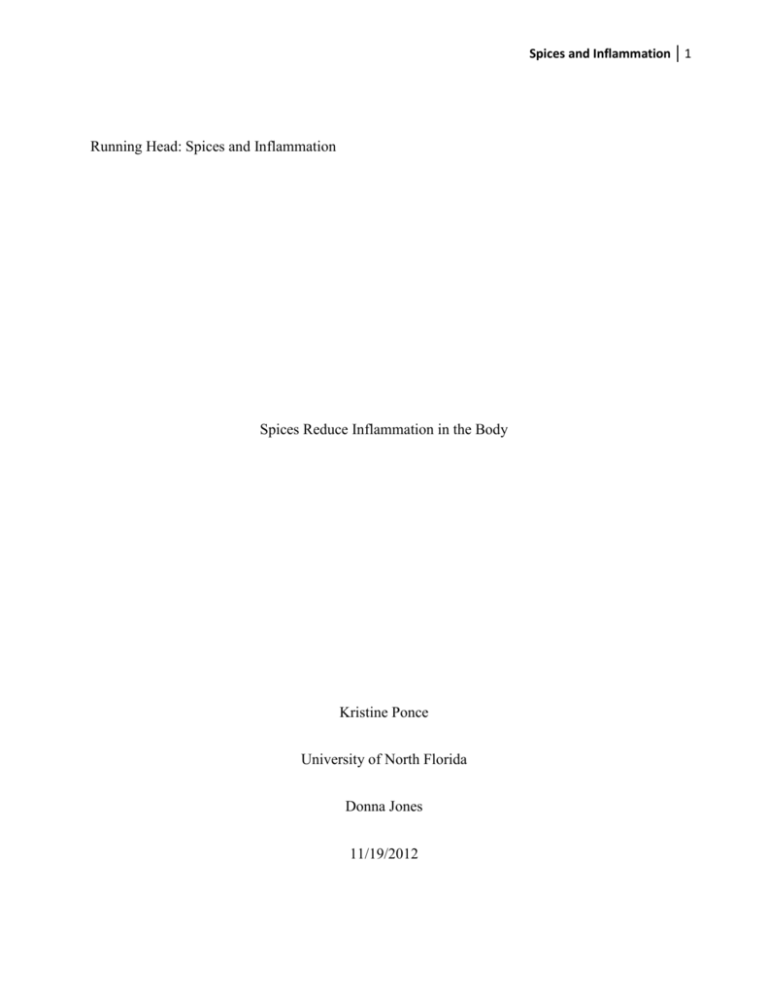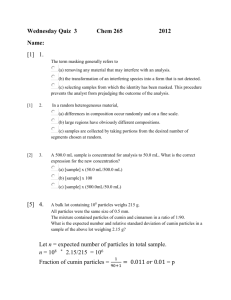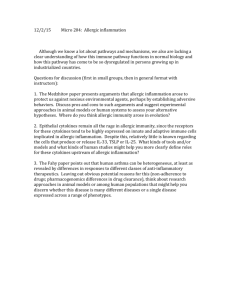Spices and Inflammation
advertisement

Spices and Inflammation 1 Running Head: Spices and Inflammation Spices Reduce Inflammation in the Body Kristine Ponce University of North Florida Donna Jones 11/19/2012 Spices and Inflammation 2 Spices and Inflammation in the Body Introduction Inflammation in the body can cause disease processes to occur in the body. These diseases consist of cardiovascular disease, cancer, and even diabetes. The literature review shows how spices, particularly cur cumin, help aid in the reduction of inflammation in the body. Cur cumin is proven to inhibit certain inflammatory responses, and stop the inflammation before it begins. By preventing or reducing inflammation in the body a person can significantly reduce their risk for cardiovascular disease, cancer, and diabetes. Background Inflammation is a chronic issue that can cause minor problems in the joints or can be more serious causing heart disease, cancer, or increased sensitivity in diabetics. NSAIDs are a common over-the-counter aid to treat inflammation. NSAID stands for nonsterodial antiinflammatory drug. According to the American Journal of Medicine, “107,000 patients are hospitalized for NSAID use and 16,500 deaths occur among arthritis patients alone.” NSAIDs can lead to other complications including ulcers, heart burn, and upset stomach. While they do aid in reducing inflammation and relieving pain in the body, these medications also cause other complications that will need to be medically addressed. Spices were first documented to be used for various health issues around the year 3500 B.C. by the Ancient Egyptians. Around 7,000 B.C. trade between and Asia and the Middle East became more popular and new spices began to be introduced. Many spices were found to have healing properties, specifically anti-inflammatory properties. Cur Cumin property found in the Spices and Inflammation 3 spice Turmeric was found to have the most anti-inflammatory response. If this proves to be correct then spices could replace harmful NSAIDs in the medical field. Inflammatory Response The inflammatory response is triggered by infection, lifestyle, and environment. It begins when there is stress in an area of the body. Macrophages release cytokines into the body as a response to this stress. The cytokine interleukin -1B (IL-1B) is one of the first to be released to the site; once at the site the cytokine proceeds to infiltrate the cells surrounding the area. During this process more cytokines are trigged and brought to the site. IL-IB begins to migrate through the blood stream to the brain. Here IL-1B will activate prostaglandin E2 which initiates the onset of fever, nausea, and other more serious symptoms. The inflammation process changes dues to different diseases. Certain neurodegenerative disorders activate the JNK pathway and 6-OHDA. The JNK pathway allows cell receptors to be passed along it to the site, including certain death receptors. One of these death receptors is 6-OHDA which attaches to the neurons in the brain. Once this is achieved neurotoxicity occurs leading to Parkinson’s, dementia, and even Alzheimer’s. Other factors contributing to neurodegenerative diseases include medulloblastoma cells regulated by the NF-kB transcription factor. A medulloblastoma is a malignant brain tumor beginning in the posterior fossa, which is the thick membrane separating the two hemispheres. NF-kB proliferation occurs from free radicals, and cytokines in the body. NF-kB binds to DNA and ultimately changes that DNA causing medulloblastomas to form. Obesity and Diabetes is induced by certain inflammation processes in the body. Cytokines released from fat include Tumor Necrosis Factor (TNF), interleukin (IL-6), monocyte chemotactic protein ((MCP)-1), and IL-1. These cytokines lead to insulin resistance and chronic Spices and Inflammation 4 inflammation. TNF is activated in body by NF-kB, which is a direct link to insulin resistance. IKK or IkB- kinase frees the NF-KB factor to roam freely in the body leading to free radicals and an increased risk for obesity. The coenzyme Acetyl CoA is the key cause of lipids in adiposities; this is a precursor to fatty acid deposits in the body. Free fatty acids activate NF-kB which leads to an excess of TNF and interleukin IL-6. This leads to a decrease in insulin sensitivity causing type 2 Diabetes. Obesity can tie to this because it increases the release of pro-inflammatory cytokine IL-6, which can also lead to cardiovascular disease. A. Jungbauer, S. Medjakovic / Maturitas 71 (2012) 227– 239 Fig. 1. Schematic overview of how metabolic syndrome develops from adipose tissue [7] Spices and Inflammation 5 The liver is susceptible to inflammation due to an increase of cytokines in this area. Here inflammation is brought on through NF-kB and JNK pathways. TNF, IL-1B, and IL-6 are activated causing greater oxidative stress levels in the body. This is known as hepatic inflammation. Prolonged oxidation and inflammation in the liver can lead to permanent liver damage or liver cancer. Common free radicals in the body that lead to cancer include IL-1B, TNF, NF-kB, and NSAID-activated gene-1 (NAG-1). ROS which are free radicals in the body are the main cause of cancer. NOS, another free radical in the body, worsens the effect of ROS by causing oxidation inflammation. COX-2 over expression is brought on by inflammation in the body. COX-2 has been found in the carcinogenesis of many tumors which lead to various different cancers; including breast, colon, pancreatic, etc. It has been proven that NF-kB is found active in many cancer patients and plays an important role in inflammation induction. Cur Cumin effect on Inflammation Cur Cumin has been shown to have anti-inflammatory effects in the body. In various disease processes such as neuro-degeneration, obesity, diabetes, and cancer cur cumin has shown to prohibit activation of these processes. By stopping certain pathways and preventing activation from occurring cur cumin stops inflammation and in turn the disease process from progressing. In neurodegenerative diseases cur cumin was found to target the JNK pathway; preventing it from releasing more cytokines into the body. Cur cumin was also found to disrupt the NF-kB pathway; protecting cells from neurotoxicity due to 6-OHDA. It was also found that cur cumin weakened malignant glioma cells and pituitary tumors. These findings were obtained by giving male rats 500 ppm of dietary cur cumin bi-weekly for a year. Another study was done to find cur cumin’s effect on stroke. An injection of 1 or 2mg/kg was injected into rats 30 Spices and Inflammation 6 minutes after focal cerebral ischemia. The result was a decrease in “infarct volume, improved neurological deficit, decreased mortality, and reduced water content of the brain.” Cur Cumin was also found to have protective agents against obesity and diabetes. Mice were given 1% w/w cur cumin to see its effect on inflammation due to obesity. It was found that cur cumin prohibited the activation of the JNK pathway. Stopping the phosphorylation of IKK prohibits the activation of NF-kB; this stops the inflammation process before it begins. Interleukin 1-B was also reduced allowing for insulin function to return to normal. NFkB, TNF, and Il-1B are all key factors in over production of insulin in diabetics. This over production of insulin leads to elevated blood sugar and increased risk for obesity. Cur Cumin given at 500gm/kg was found to reduce these pathways. A study was done to see cur cumin’s affect on liver infection. Rats were given 18.5 ug/ml of cur cumin for 8 weeks. Cur cumin was found to decrease the activation of NF-kB in the liver as well as reduce the effects of pro-inflammatory cytokines. Through the suppression of NF-kB cells were protected against liver fibrosis. Hepatic inflammation was reduced in the rats along with a reduction in oxidative stress suggesting that cur cumin has anti-inflammatory and anti-oxidant effects. Another study evaluated fatty liver diseases by giving 1% w/w of cur cumin to mice. It was found that Triglyceride levels in the liver were greatly lowered. This would propose that cur cumin could be useful in the treatment of hyperlipidemia and obesity. Human studies were done however, that should cur cumin may not be of beneficial value. A study done in Taiwan gave volunteers 8,000 mg of cur cumin for three months and found that the levels in the body quickly wore off after 12 hours and was only highly effect 1 to 2 hours directly after administration. Another study done in the U.S. gave a much smaller dose at 50-200 mg and found no trace of the spice in their volunteers. England did a study to test cur cumin’s Spices and Inflammation 7 toxicity levels and its bioavailability. They gave 15 people 180 mg of cur cumin mixed with volatile oils found in curcuminoid. The result was that the patients received no toxicity from the oils but that the bioavailability of cur cumin was very low. This study went further to select 12 patients who had colorectal cancer. They administered 450, 18,000, or 3,600 mg of cur cumin 7 days prior to surgery. It was determined that the levels of cur cumin needed to have any drug like effect on hepatic levels would not be reasonable in humans. Due to cur cumin’s anti-oxidative properties it is still thought that it could be used for the treatment of cancer despite the previous studies. Rats were given 10um of cur cumin, and it was proven that cur cumin did destroy the production of ROS. It was also shown that cur cumin could have effect as a chemoprevention, when mice were given 1-20um of cur cumin and had greatly reduced macrophage NOS activity. Cur cumin was found to have effects inhibiting inflammation by stopping the arachidonic acid pathway which promotes COX-2 an Spices and Inflammation 8 inflammatory agent. COX-2 is expressed in the brain causing tumors and leading to cancer. By reducing the effect of COX-2 it prohibited the pathway of NF-kB and the expression of IKK. This has been directly linked to the decrease in risk for colorectal cancer. NF-kB has been directly linked to cancer and tumors in the body. Due to cur cumin’s multi-cellular approach to inflammation makes it a key drug idea for cancer. Conclusion Cur cumin has been proven to have anti-inflammatory and anti-oxidative effects. Reduction of inflammation and oxidation in the body leads to a lesser risk of cancer, obesity, diabetes, and heart disease. The studies proved that cur cumin has the ability to prevent disease Spices and Inflammation 9 processes in the body. Unfortunately, the studies also showed that the amounts of cur cumin necessary to act as a pharmaceutical against these disease processes would not be feasible for a person to consume. Since cur cumin was shown to have beneficial properties it would be good to take as a preventative before inflammation and oxidation occurs in the body; taking upward limits of 3,600mg a day. Spices and Inflammation 10 References 1. Aggarwal BB. Targeting Inflammation-Induced Obesity and Metabolic diseases by Curcuma and other nutraceuticals. Annu Rev Neutr. 2010, 30:173-199 2. Aggarwal BB, Gupta SC, Kannappan R, Kim JH, Reuter S. Neuroprotection by SpiceDerived Nutraceuticals: You Are What You Eat. Mol Neurobiol. 2011, 44: 142- 159 3. Alappat L, Awad A. Curcumin and Obesity: Evidence and Mechanisms. Nut Rev. 2010, 68(12): 729-738 4. Barret EP, Basch E, Ulbricht C., et. Al; Turmeric (Curcuma Longa). Natural Standard. 2011, 17: 225-236 5. Basnet P, Basnet NS. Curcumin: An anti-inflammatory molecule from curry spice on the pathway to cancer prevention. MDPI. 2011, 16: 4567-4598 6. Bystrianyk R. Toxi and Deadly NSAID. Health Sent. 2010. 7. Chao JC, Chang CC, Tam KW, Tsai YH, Wu SJ. Curcumin and Saikosaponin A Inhibit Chemical-Induced Liver Inflammation and Fibrosis in Rats. Am Jo of Chinese Med. 2010. 38: 99-111. 8. Cherian OL,Nisha VM, Padmakumari KP, Priyarani M, Raghu KG, Sankarikutty B. Inhibitory potential of ginger extracts against enzymes linked to type 2 diabetes, inflammation and induced oxidative stress. In Jo of Nat Food and Sci. 2011. 62(2): 106110. 9. Jungbauer A, Medjakovic S. Anti-inflammatory properties of culinary herbs and Spices that ameliorate the effect of metabolic syndrome. Maturitus. 2011. 71: 227-239. Spices and Inflammation 11





